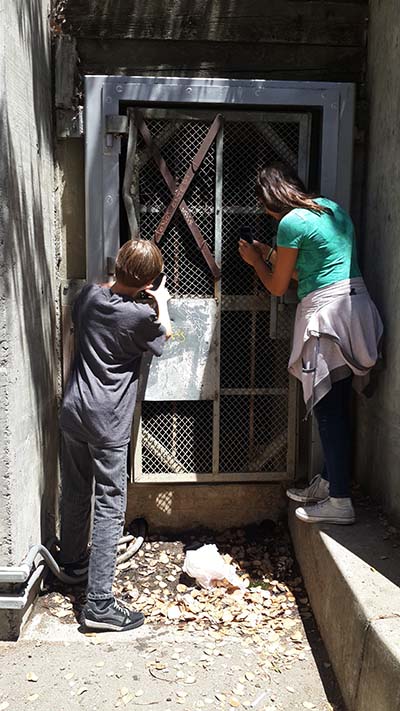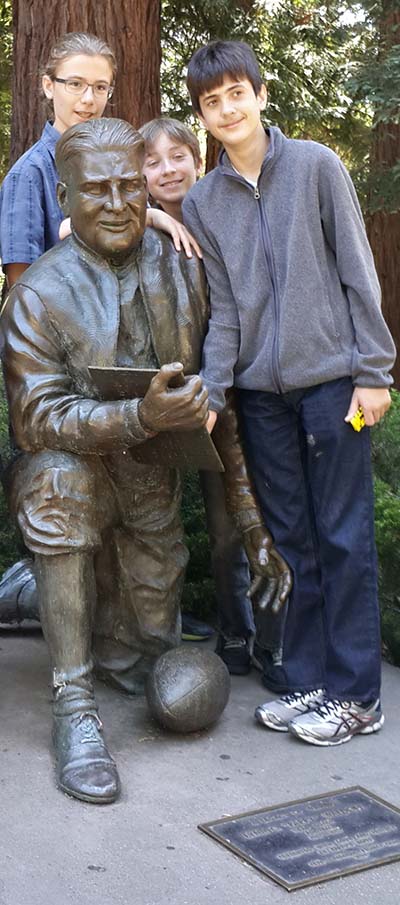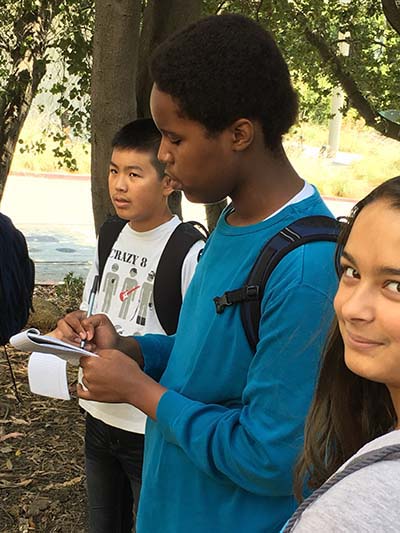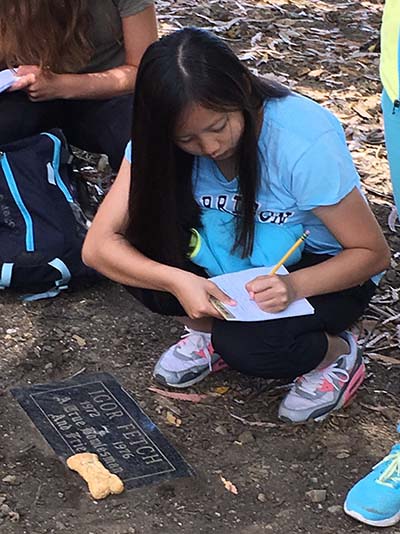Summer myth-busters tackle campus tall tales
Students in the summer Academic Talent Development Program are sharpening their reporting skills by investigating Berkeley lore.

July 25, 2016
Is a dog named Igor buried on campus? Does the Bancroft Library contain a book bound in human skin? In the Faculty Club, does a ghost haunt an upper room?
Eleven budding reporters from grades 6-12 attending the Academic Talent Development Program (ATDP) through the Graduate School of Education this summer are learning to separate fact from fiction by investigating myths and contemporary legends about UC Berkeley and writing deadline stories about their findings.

Gryffen Mendelssohn and Sonja Kaleva discover the tunnel drilled by mining students in the early 1900s and take photos. (Photo by Elizabeth Scherman)
Their instructor, Elizabeth Scherman, a former Tacoma News Tribune reporter and a professor at Bates Technical College in Washington, says she’s teaching “critical thinking and how to analyze the credibility of sources. In this digital age, young people are getting a lot of inaccurate information from social media.”
When looking for facts, the teens instinctively go online, says Scherman. But she’s also urging them to question a source’s validity, to seek out a primary source — preferably someone with firsthand knowledge — and to do their own on-site investigations.
“I like how we take trips and interview people like a reporter would do,” said Adya Gupta, 13. “It’s a privilege to be (at Berkeley) and learning so much … and I love mysteries.”
Skin and bones
As for the mystery of the flesh-bound book, L’office de l’Eglise en François, a French religious text in the Bancroft Library that dates from the 1790s, the students got help from Nancy Oanh Tran, a campus library circulation supervisor. The headline for a 2006 National Geographic article the students found about the text reads “Book Bound in Human Skin.” The practice, called anthropodermic bibliopegy, dates back to at least the 17th century.
But Tran had updated information. In a 2016 Daily Cal interview, Bancroft Library curator David Faulds said a scientific process called peptide mass fingerprinting analysis, done in 2015 on small fragments of the book’s cover by a scientist affiliated with Harvard University concluded that the cover was really made of horse and goat skin.

Students in a summer ATDP course pose with statue of former Cal football coach Pappy Waldorf. (Photo by Elizabeth Scherman)
Gryffen Mendelssohn, who is entering 7th grade, says he was “kind of disappointed” that the tale wasn’t true. But he adds that tall tales might come in handy. “I’d tell them to people younger than me,” he says, “to creep them out.”
The teens also verified that there are bones — but not human ones — in the Campanile, and a few of them investigated the statue of Pappy Waldorf, Cal football coach from 1947-1956, which stands near Faculty Glade. The story goes that it was positioned so Pappy could look directly at a nearby statue of a naked wood nymph. In the early 2000s, the Rally Committee even began blindfolding Pappy during home games so he wouldn’t lose his focus on winning, says Berkeley alumna Maya Goehring-Harris, assistant director of external relations in University Development and Alumni Relations.
Scherman says her students lined up behind Pappy’s head and “gazed to where he appears to be gazing. Intentional or not, it was toward the dryad. They found it amusing.”
Community historian Steve Finacom, who helped site the statue when it was donated, says Pappy was intentionally placed facing the dryad so “people viewing or approaching Pappy from Faculty Glade would see him from the front, not the ample posterior” of the kneeling, larger-than-life statue.
“The neat thing about Berkeley is that, sometimes, fiction becomes fact. When we tell stories enough, they become our own truth,” says Goehring-Harris, who also is a former chair of the Rally Committee. “And new stories are always being created.”
Myths and legends “are harmless and fun,” adds Anuka Mohanpuhr, 14. “They’re a good way to learn more about the history of the university.”
A ghost and a grave

Teens Jude Muriithi, Sonja Kaleva and Joshua Chang conduct interviews for an assignment. (UC Berkeley photo by Gretchen Kell)
The story of the Faculty Club ghost involves reported manifestations of former Department of History chair Henry Morse Stephens, who lived in Room 219 during part of his 1902-1919 tenure. In a newspaper clipping from 1974, a visiting professor from Japan says he encountered Stephens’ ghost while staying in the room.
In 2009, a Berkeley journalism student invited psychic Charles Peden to Stephens’ former room, but Peden claimed in a radio story to have encountered a different ghost there — that of a member of the 1920 Cal football team.
Scherman says the ATDP youngsters “walked by (the Faculty Club) and called (Stephens’) name and felt brave doing that.”
The students — eight in Scherman’s Journalism Boot Camp class and three in her Urban Legends class — also found proof of a tunnel drilled by mining students in the early 1900s and that there’s a small space on Sproul Plaza — a monument to the Free Speech Movement — free from laws or jurisdiction.

Sunny Wang takes notes at the grave of Igor Fetch, a pet at Bowles Hall in the 1970s. (UC Berkeley photo by Gretchen Kell)
But they had their greatest success at Bowles Hall, where they discovered the grave of a beloved dog who lived at the historic residence hall from 1972-1976. Bowles will reopen next month as a residential college following an extensive renovation project.
In 1976, the mutt’s death on a nearby road prompted Bowles residents to give him a proper burial, complete with a granite marker inscribed “Igor Fetch, 1972-76, a True Bowlesman and Friend.” But his resting place — on the front lawn beneath a flat granite marker often covered by leaves — and even his very existence have been largely unknown.
Through research, the ATDP teens pieced together Igor’s story and then headed to Bowles Hall, where they spotted the gravestone and, taking careful notes, interviewed Jack Scanlin, project manager for the Bowles renovation, and placed a bone-shaped dog biscuit bearing the pet’s name on Igor’s marker.
The class then developed, on deadline, concise stories about Igor. Mohanpuhr says she enjoys the challenge of learning to boil down her notes into terse copy that exemplifies how “less is more.”
“Igor lived in the building and often wandered, until he died, possibly crossing the road,” wrote one of Scherman’s students. “His spirit was just like the boys who lived there: wild and free.”